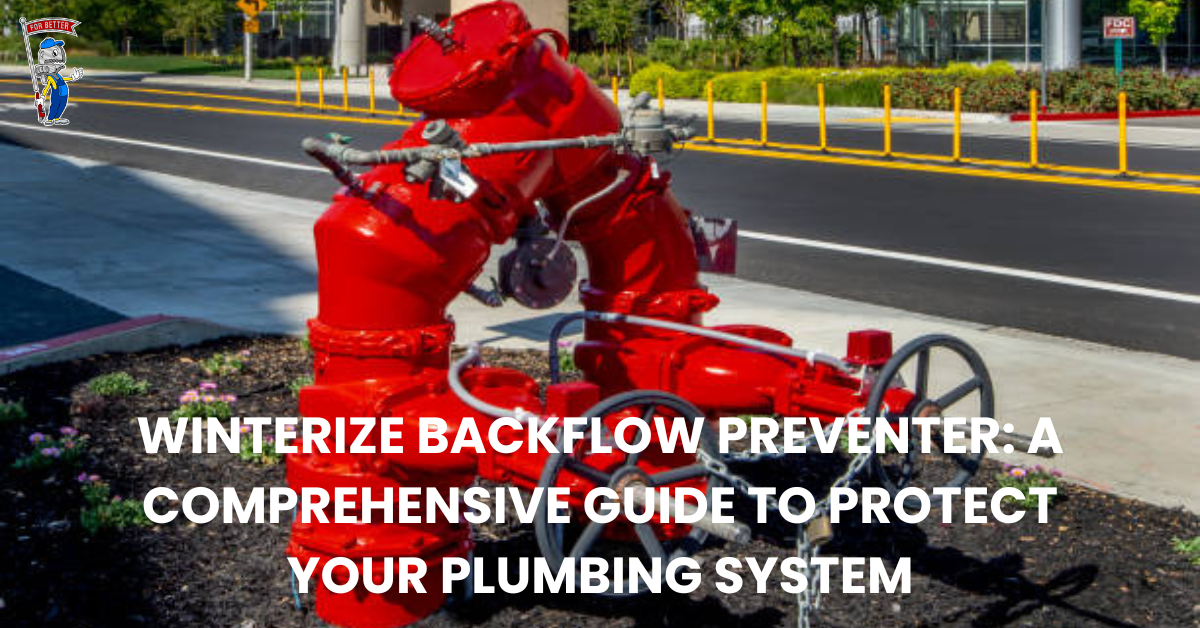Introduction
Winter is here, and our homes face lots of challenges, including something called a backflow preventer. As temperatures drop, there’s a risk of pipes freezing and causing trouble. This guide will help you understand why it’s important to winterize backflow preventers, explain the steps clearly, talk about the benefits, and help you decide if you should do it yourself or get professional help.
Why Winterizing Backflow Preventer Matters:
Imagine a really cold night, and your backflow preventer is out there exposed to the cold. When water inside it freezes, it can break and cause big problems. Winterizing your backflow preventer isn’t just a good idea; it’s like giving your pipes a warm blanket to stay safe and avoid expensive repairs. It’s not just about protecting the backflow preventer; it’s about making sure your whole plumbing system stays in good shape.
But why do this? Think of your backflow preventer as a guard for clean water. If it breaks due to freezing, dirty water might flow back into your house, which is not safe. Winterizing is a small cost now to make sure your water stays clean, and your plumbing stays strong.
Simple Steps to Winterize Your Backflow Preventer:
Now that you know it’s important, let’s talk about how to do it. Winterizing your backflow preventer is not hard; you just need to follow a few easy steps:
1.) Gathering the Necessary Tools
Time to play handyman! You’ll need a few tools to get the job done – a wrench, insulation materials, and possibly a tarp or cover. Make sure you have everything on hand before you start the winterizing process.
2.) Turning Off the Water Supply
Begin by shutting off the water supply to your backflow preventer. This is usually done at the main water valve. Using your wrench, give it a gentle turn until it’s tightly closed. This step ensures that no water is circulating through the preventer during the winter months.
3.) Draining the System
Open the test cocks on your backflow preventer. This will allow any remaining water to drain out of the device. Take a moment to marvel at the simplicity of this step – a small action with a big impact on preventing freezing and damage.
Does this sound complicated? Don’t worry; our experts are just a call away to guide you through the process. Contact Us now!
4.) Insulating the Backflow Preventer
Time to bundle up your backflow preventer! Use insulation materials to wrap the entire device. Pay special attention to vulnerable parts like the pipes and valves. This protective layer acts as a winter coat, shielding your preventer from the biting cold.
5.) Adding a Protective Cover
For an extra layer of defense, consider covering your backflow preventer with a tarp or cover. This shield will keep snow, ice, and debris away, preventing any potential damage. It’s like giving your preventer cozy shelter for the winter.
6.) Regular Check-ups
Winterizing isn’t a one-and-done deal. Periodically check your backflow preventer throughout the winter to ensure everything is in order. Remove any accumulated snow or ice and make sure the insulation is still intact.
Our maintenance plans include regular check-ups to keep your backflow preventer in top shape. Book an appointment with us today and enjoy a worry-free winter!
7.) Spring Awakening
As the warmer days approach, it’s time to wake up your backflow preventer. Remove the insulation and covers, close the test cocks, and slowly turn on the water supply. This gradual awakening prevents any sudden pressure surges, ensuring a smooth transition into the active season.
Benefits of Winterizing Backflow Preventer
Beyond the routine maintenance, winterizing your backflow preventer comes with a host of benefits that extend far beyond the chilly months.
Preventing Freezing Damage
The most obvious advantage of winterizing your backflow preventer is protecting it from freezing temperatures. When water inside the device freezes, it expands, leading to potential cracks and damage. Winterization ensures a thorough drain, leaving no room for icy mischief.
Extending Lifespan
Just like any other piece of equipment, a backflow preventer benefits from a little TLC. By winterizing it, you’re essentially giving it a longevity boost. Think of it as an investment in the long-term functionality of your plumbing system.
Avoiding Costly Repairs
Repairing a damaged backflow preventer can be a pricey affair. Winterizing is a cost-effective preventive measure that spares you from shelling out substantial amounts of repairs caused by winter-related issues.
Ready to save on potential repairs? We at Backflow Services Done Right can help you with all your backflow needs and help you with securing your plumbing system!
Maintaining Water Quality
A properly functioning backflow preventer ensures that contaminated water doesn’t flow back into your clean water supply. Winterization safeguards this functionality, preserving the quality of the water that reaches your faucets.
Compliance with Regulations
Many areas have regulations in place that mandate the winterization of backflow preventers. By adhering to these guidelines, you not only ensure the proper functioning of your preventer but also avoid any legal hassles.
Peace of Mind
Knowing that your plumbing system is winter-ready brings a sense of peace. No more late-night worries about frozen pipes or potential water contamination. Winterizing your backflow preventer translates to a worry-free winter season.
Environmentally Friendly
Beyond personal benefits, winterizing your backflow preventer has positive environmental implications. By preventing leaks and contamination, you contribute to the conservation of water resources and protect the ecosystem.
Enhancing System Efficiency
A well-maintained backflow preventer contributes to the overall efficiency of your plumbing system. It ensures smooth water flow, preventing any disruptions that may arise from frozen or damaged components.
DIY or Professional Help?
Now that you know why and how, let’s talk about who should do it: you or a professional.
DIY Approach
Doing it yourself is okay if you’re comfortable with simple plumbing tasks. Just follow the steps mentioned, and it can save you some money. But be careful; mistakes could make things worse.
Professional Winterization
Getting professionals to do it ensures a good job. They know what to look for and can make sure everything is done right. It might cost a bit more, but it’s an investment that pays off in the long run.
When to Winterize
1.) Consider the Climate
The first factor to weigh when deciding when to winterize is your local climate. If you reside in an area where temperatures start to drop significantly in the fall, it’s advisable to schedule winterization before the first freeze. Early action helps you stay ahead of the frost and potential damage.
2.) Autumn Preemptiveness
As the leaves change color, it’s a cue to consider winterizing your backflow preventer. Aim to complete the process in the early to mid-fall, giving your plumbing system ample time to adjust before the deep freeze sets in.
3.) Check Local Regulations
Some regions have specific regulations regarding the winterization of backflow preventers. Check with local authorities or water departments to understand any mandated timelines. Compliance not only ensures the proper functioning of your preventer but also avoids potential penalties.
4.) Monitor Weather Forecasts
Keep an eye on weather forecasts as fall progresses. If an unexpected cold front is on the horizon, consider moving up your winterization schedule. Being proactive can prevent last-minute scrambles and potential damage.
5.) Vegetation Changes
Nature provides subtle clues. When you notice a decline in vegetation and the first signs of winter approaching, it’s an opportune time to winterize. This ensures that your backflow preventer is protected before the harshest weather arrives.
6.) Regular Inspection Intervals
If you’ve been diligent about regular maintenance and inspections, you may already have a good sense of the condition of your backflow preventer. Consider the history of your plumbing system when determining the ideal time for winterization.
Timing is indeed everything when it comes to winterizing your backflow preventer. By considering local climate patterns, regulations, and the subtle cues of nature, you can ensure that your plumbing system is well-protected before winter’s chill sets in.
Ready to choose the perfect time for winterization? Call us now and let’s ensure your backflow preventer is winter-ready!
Frequently Asked Questions
Why is it necessary to winterize my backflow preventer?
Winterizing is crucial to protect your backflow preventer from freezing temperatures. When water inside the device freezes, it can expand and lead to cracks or damage, compromising its functionality.
When is the best time to winterize my backflow preventer?
The ideal time is in early to mid-fall before temperatures drop significantly. Consider your local climate and regulatory requirements, and weather forecasts to determine the most suitable timing.
Can I winterize my backflow preventer myself, or should I hire a professional?
While some homeowners may choose to DIY, hiring a professional ensures the job is done thoroughly and correctly. Professionals have the expertise to detect and address potential issues that may go unnoticed by the untrained eye.
What are the signs that my backflow preventer may need winterization?
Signs include dropping temperatures, the onset of fall, and changes in vegetation. Additionally, if you’ve experienced freezing issues in the past or plan to be away during the winter, it’s advisable to winterize your backflow preventer.
Is winterizing only necessary for residential properties?
No, winterizing is recommended for both residential and commercial properties. Any property with a backflow preventer should undergo winterization to avoid potential damage and ensure continued functionality.
What if I forget to winterize my backflow preventer?
If you forget to winterize and freezing temperatures are imminent, it’s crucial to act quickly. Shut off the water supply, drain the system, and contact a professional for assistance to minimize potential damage.



